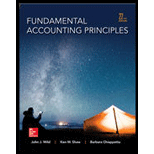
Debt-to-Equity Ratio:
It is a financial ratio which compares the borrowed funds and owned funds to determine the proportion of debt and equity invested in the total asset of a company. It is generally computed by dividing the total liabilities or debt by the total
To determine:
1. Computation of (a) Present debt-to-equity ratio and (b) the debt-to-equity ratio assuming it borrows $500,000 to fund the project.
2. Evaluate and discuss the level of risk involved if Montclair borrows the funds to pursue the project.
Answer to Problem 12E
Solution:
1. (a) Present Debt-to-Equity is 0.55 and (b) Potential Debt-to-Equity is 1.80.
2. If Montclair borrows the funds to pursue the project, the level of risk increases with the increase in the proportion of debt in capital of the company.
Explanation of Solution
Explanation:
2.
If the company borrows the fund for the project, the debt-to-equity ratio is 1.80 which means that the borrowed funds 80% more than the owned funds. The debt of a company comes with liability obligation of interest and repayment of the principal. Montclair must pay the interest and the principal amount whether the company makes profit from the project or not. So it increase the level of risk in pursuing the project with the borrowed funds.
Conclusion:
Hence it is concluded that the debt-to-equity of Montclair increases to 1.80 when it borrows $500,000 additional liabilities for the project which increases the level of risk regarding the payment of interest and repayment of principal amount.
Want to see more full solutions like this?
Chapter 14 Solutions
Fundamental Accounting Principles -Hardcover
- Compare and contrast the procedures for lodging an objection in Jamaica with those of Trinidad and Tobago.arrow_forwardThe actual cost of direct labor per hour is $16.25 and the standard cost of direct labor per hour is $15.00. The direct labor hours allowed per finished unit is 0.60 hours. During the current period, 4,500 units of finished goods were produced using 2,900 direct labor hours. How much is the direct labor rate variance? A. $3,625 favorable B. $3,625 unfavorable C. $4,350 favorable D. $4,350 unfavorablearrow_forwardOn January 1 of the current year, Piper Company issues a 4-year, non-interest-bearing note with a face value of $8,000 and receives $4,952 in exchange. The recording of the issuance of the note includes a: a. credit to Notes Payable for $4,952. b. credit to Discount on Notes Payable for $3,048. c. debit to Discount on Notes Payable for $3,048. d. debit to Cash for $8,000.arrow_forward
- During September, the assembly department completed 10,500 units of a product that had a standard materials cost of 3.0 square feet per unit at $2.40 per square foot. The actual materials purchased consisted of 22,000 square feet at $2.60 per square foot, for a total cost of $57,200. The actual material used during this period was 25,500 square feet. Compute the materials price variance and materials usage variance.arrow_forwardBluesy Electronics recorded the following financial data: Net Sales $720,500 Average Inventory at Cost = $80,200 Gross Margin Percentage = 42% Calculate the GMROI.arrow_forwardNeed help this question solutionarrow_forward

 AccountingAccountingISBN:9781337272094Author:WARREN, Carl S., Reeve, James M., Duchac, Jonathan E.Publisher:Cengage Learning,
AccountingAccountingISBN:9781337272094Author:WARREN, Carl S., Reeve, James M., Duchac, Jonathan E.Publisher:Cengage Learning, Accounting Information SystemsAccountingISBN:9781337619202Author:Hall, James A.Publisher:Cengage Learning,
Accounting Information SystemsAccountingISBN:9781337619202Author:Hall, James A.Publisher:Cengage Learning, Horngren's Cost Accounting: A Managerial Emphasis...AccountingISBN:9780134475585Author:Srikant M. Datar, Madhav V. RajanPublisher:PEARSON
Horngren's Cost Accounting: A Managerial Emphasis...AccountingISBN:9780134475585Author:Srikant M. Datar, Madhav V. RajanPublisher:PEARSON Intermediate AccountingAccountingISBN:9781259722660Author:J. David Spiceland, Mark W. Nelson, Wayne M ThomasPublisher:McGraw-Hill Education
Intermediate AccountingAccountingISBN:9781259722660Author:J. David Spiceland, Mark W. Nelson, Wayne M ThomasPublisher:McGraw-Hill Education Financial and Managerial AccountingAccountingISBN:9781259726705Author:John J Wild, Ken W. Shaw, Barbara Chiappetta Fundamental Accounting PrinciplesPublisher:McGraw-Hill Education
Financial and Managerial AccountingAccountingISBN:9781259726705Author:John J Wild, Ken W. Shaw, Barbara Chiappetta Fundamental Accounting PrinciplesPublisher:McGraw-Hill Education





